Categories Society
7 days
30 days
All time
Recent
Popular
Hi @chelwestft @EHRC @EHRCChair @KishwerFalkner @RJHilsenrath @trussliz @GEOgovuk
The Equal opportunities section in your job application mentions the Equality Act 2010 four times and correctly lists sex as a protected characteristic. However...
1/11
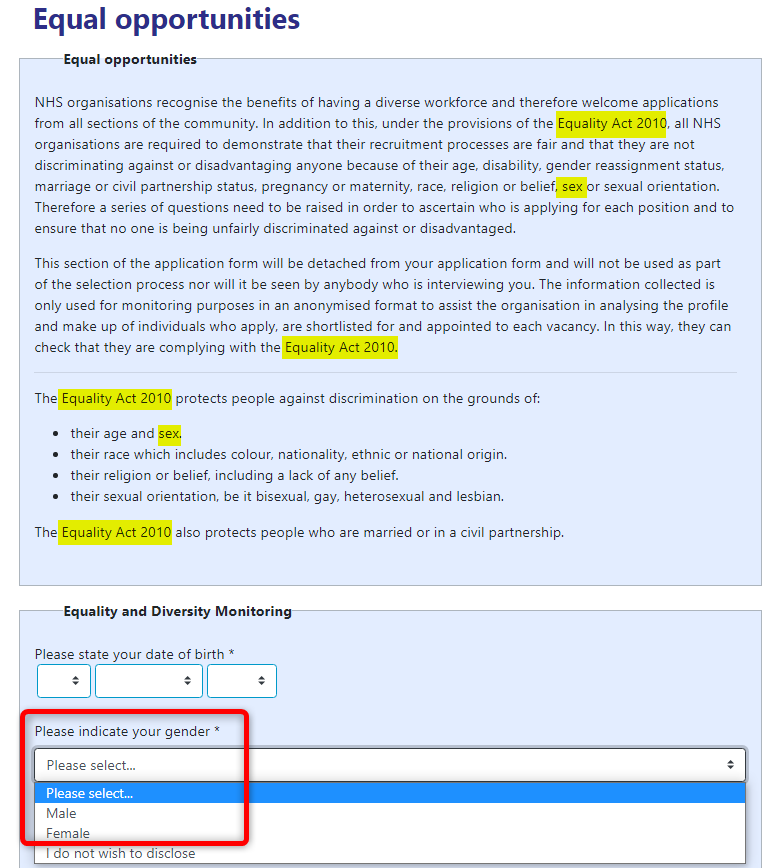
However, you then ask for the 'gender' of the applicant with options:
Male
Female.
2/11
'Gender' is not a protected characteristic under the Equality Act 2010 and is not defined in the Act.
https://t.co/qisFhCiV1u
3/11
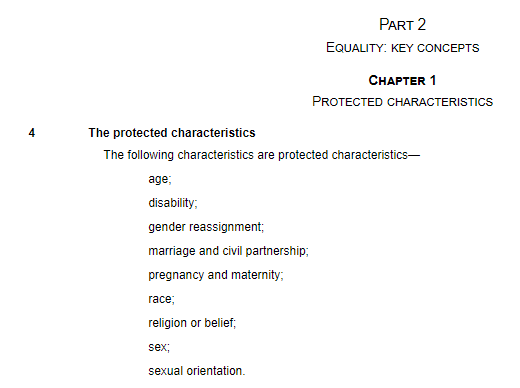
Sex is the protected characteristic and the only two possible options for sex are 'Female' and 'Male' as defined in the Act and consistent with biology and there is no way to self-describe one's sex.
https://t.co/CEJ0gkr6nF
'Gender' is not a synonym for sex.
4/11

Asking about a personal characteristic such as 'gender' that is not a protected characteristic under the Act, may be in breach of the GDPR by processing personal - and potentially Special Category - data without a lawful basis.
5/11
The Equal opportunities section in your job application mentions the Equality Act 2010 four times and correctly lists sex as a protected characteristic. However...
1/11

However, you then ask for the 'gender' of the applicant with options:
Male
Female.
2/11
'Gender' is not a protected characteristic under the Equality Act 2010 and is not defined in the Act.
https://t.co/qisFhCiV1u
3/11

Sex is the protected characteristic and the only two possible options for sex are 'Female' and 'Male' as defined in the Act and consistent with biology and there is no way to self-describe one's sex.
https://t.co/CEJ0gkr6nF
'Gender' is not a synonym for sex.
4/11

Asking about a personal characteristic such as 'gender' that is not a protected characteristic under the Act, may be in breach of the GDPR by processing personal - and potentially Special Category - data without a lawful basis.
5/11
Hi @ASA_UK @EHRC @EHRCChair @KishwerFalkner @RJHilsenrath @trussliz @GEOgovuk
The Diversity details section of your job application has what appears to be a partial list of the protected characteristics under the Equality Act 2010. However, it has 'gender' but not sex.
1/10
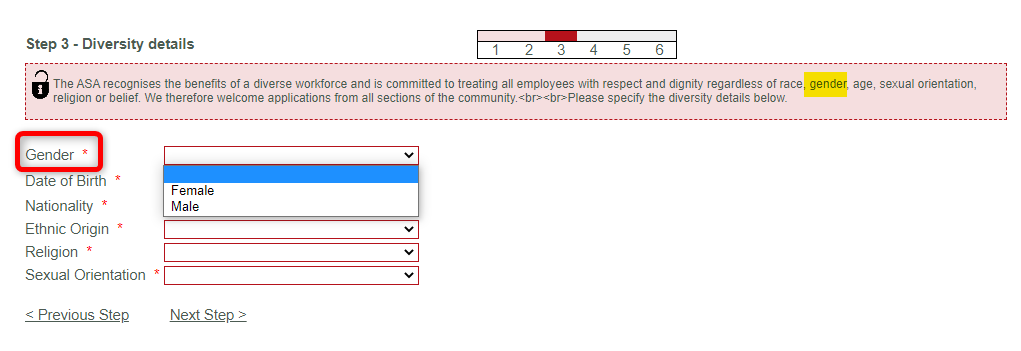
'Gender' is not a protected characteristic under the Equality Act 2010 and is not defined in the Act.
Sex is the protected characteristic under the Act, but that is not on your list.
https://t.co/qisFhCiV1u
2/10
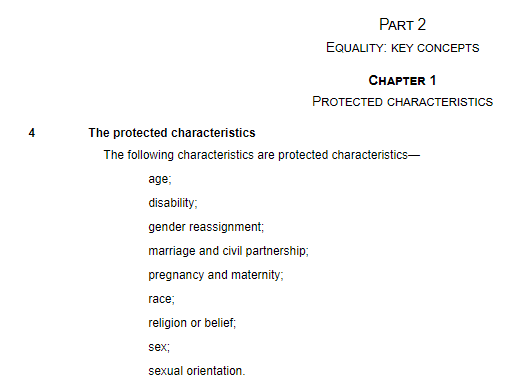
You then ask for the 'gender' of the applicant with options:
Female
Male.
3/10
'Gender' is not a protected characteristic under the Equality Act 2010 and is not defined in the Act.
https://t.co/qisFhCiV1u
4/10

Sex is the protected characteristic and the only two possible options for sex are 'Female' and 'Male' as defined in the Act and consistent with biology, but you don't ask for that.
https://t.co/CEJ0gkr6nF
'Gender' is not a synonym for sex.
5/10

The Diversity details section of your job application has what appears to be a partial list of the protected characteristics under the Equality Act 2010. However, it has 'gender' but not sex.
1/10

'Gender' is not a protected characteristic under the Equality Act 2010 and is not defined in the Act.
Sex is the protected characteristic under the Act, but that is not on your list.
https://t.co/qisFhCiV1u
2/10

You then ask for the 'gender' of the applicant with options:
Female
Male.
3/10
'Gender' is not a protected characteristic under the Equality Act 2010 and is not defined in the Act.
https://t.co/qisFhCiV1u
4/10

Sex is the protected characteristic and the only two possible options for sex are 'Female' and 'Male' as defined in the Act and consistent with biology, but you don't ask for that.
https://t.co/CEJ0gkr6nF
'Gender' is not a synonym for sex.
5/10

The right: *uses social media to plot violent overthrow of country*
Social media: *bans people plotting or encouraging violent overthrow of country*
The right: It's not fair! You're just attacking us because of our politics. You're being anti-democratic!
Everyone else:

The way Republicans and the right have responded to the Jan. 6 attack--explicitly by Trump supporters on Trump's behalf--has been an abusive tactic known as
DARVO is so effective because perpetrators of abuse twist reality so their victims look less believable and more aggressive.
Hence Republicans on the evening of the attack saying, "We're better than this. This is what Democrats do, not what we do."
Social media: *bans people plotting or encouraging violent overthrow of country*
The right: It's not fair! You're just attacking us because of our politics. You're being anti-democratic!
Everyone else:

The way Republicans and the right have responded to the Jan. 6 attack--explicitly by Trump supporters on Trump's behalf--has been an abusive tactic known as
DARVO: Deny, Attack, Reverse Victim and Offender: https://t.co/Q2ofRX13tl
— Olivia Waite (@O_Waite) January 9, 2021
DARVO is so effective because perpetrators of abuse twist reality so their victims look less believable and more aggressive.
Hence Republicans on the evening of the attack saying, "We're better than this. This is what Democrats do, not what we do."
A thread about "The Ideal Calibre Panel".
This is the nickname for a panel of people involved in trying to identify the "ideal" calibre for small arms post-1945.
1a/
The Panel came into being following a recommendation of the Standard SAA Round Sub-Committee which met on 8 February 1945.
This was a sub-committee of the Standing Committee on Infantry Weapons Development, that was created following the GS policy to adopt rimless SAA.
1b/

Note the framing as the identification of an "Ideal".
The use of this word is political.
It is designed to push the principal actors who had different views about small arms towards the solution being worked on by Brigadier Barlow and the Armament Design Establishment.
2a/
Thread on Brigadier Barlow here:
2b/
Thread on the Armament Design Establishment and the Design Department
This is the nickname for a panel of people involved in trying to identify the "ideal" calibre for small arms post-1945.
1a/
The Panel came into being following a recommendation of the Standard SAA Round Sub-Committee which met on 8 February 1945.
This was a sub-committee of the Standing Committee on Infantry Weapons Development, that was created following the GS policy to adopt rimless SAA.
1b/

Note the framing as the identification of an "Ideal".
The use of this word is political.
It is designed to push the principal actors who had different views about small arms towards the solution being worked on by Brigadier Barlow and the Armament Design Establishment.
2a/
Thread on Brigadier Barlow here:
2b/
So I said that I'd pick up the story of Brigadier Barlow in a subsequent thread.
— Dr Matthew Ford (@warmatters) January 3, 2021
Alongside Colonel Ren\xe9 Studler of the US Ordnance Corps, Brigader Barlow was instrumental in the post-war discussions of small arms ammunition and weapon standardisation.
1/ https://t.co/enkgmY40W4
Thread on the Armament Design Establishment and the Design Department
A thread on the Armament Design Establishment (SA).
— Dr Matthew Ford (@warmatters) December 31, 2020
If we're going to talk post-war small arms & NATO small arms and ammunition standardisation then we also have to talk about the ADE(SA).
This is a photo of the entire Cheshunt establishment in 1945.
1/ pic.twitter.com/HHeap7Imq2
Hi @bmj_latest @bmj_company @trishgreenhalgh @EHRC @EHRCChair @KishwerFalkner @RJHilsenrath @trussliz @GEOgovuk
The EEO section of your job application has 'gender' in what appears to be a list of the protected characteristics under the Equality Act 2010.
1/11
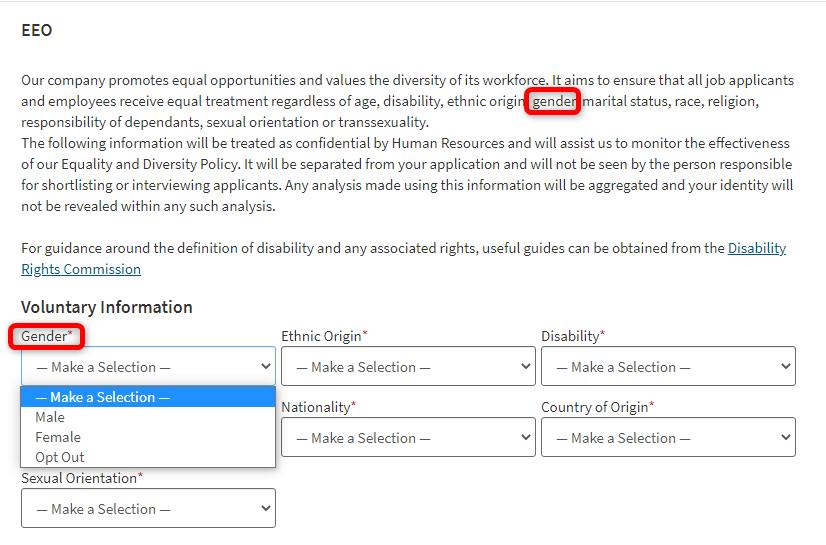
'Gender' is not a protected characteristic under the Equality Act 2010 and is not defined in the Act.
https://t.co/qisFhCiV1u
2/11

Sex is the protected characteristic under the Act, but that is not on your list.
'Gender' is not a synonym for sex.
3/11
You then ask for the 'gender' of the applicant with options:
Male
Female.
4/11
'Gender' is not a protected characteristic under the Equality Act 2010 and is not defined in the Act.
https://t.co/qisFhCiV1u
5/11
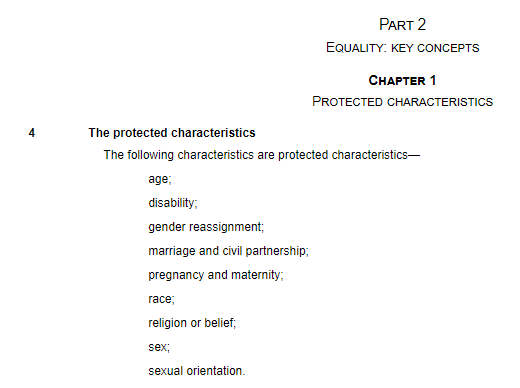
The EEO section of your job application has 'gender' in what appears to be a list of the protected characteristics under the Equality Act 2010.
1/11

'Gender' is not a protected characteristic under the Equality Act 2010 and is not defined in the Act.
https://t.co/qisFhCiV1u
2/11

Sex is the protected characteristic under the Act, but that is not on your list.
'Gender' is not a synonym for sex.
3/11
You then ask for the 'gender' of the applicant with options:
Male
Female.
4/11
'Gender' is not a protected characteristic under the Equality Act 2010 and is not defined in the Act.
https://t.co/qisFhCiV1u
5/11

I've seen many news articles cite that "the UK variant could be the dominant strain by March". This is emphasized by @CDCDirector.
While this will likely to be the case, this should not be an automatic cause for concern. Cases could still remain contained.
Here's how: 🧵
One of @CDCgov's own models has tracked the true decline in cases quite accurately thus far.
Their projection shows that the B.1.1.7 variant will become the dominant variant in March. But interestingly... there's no fourth wave. Cases simply level out:
https://t.co/tDce0MwO61
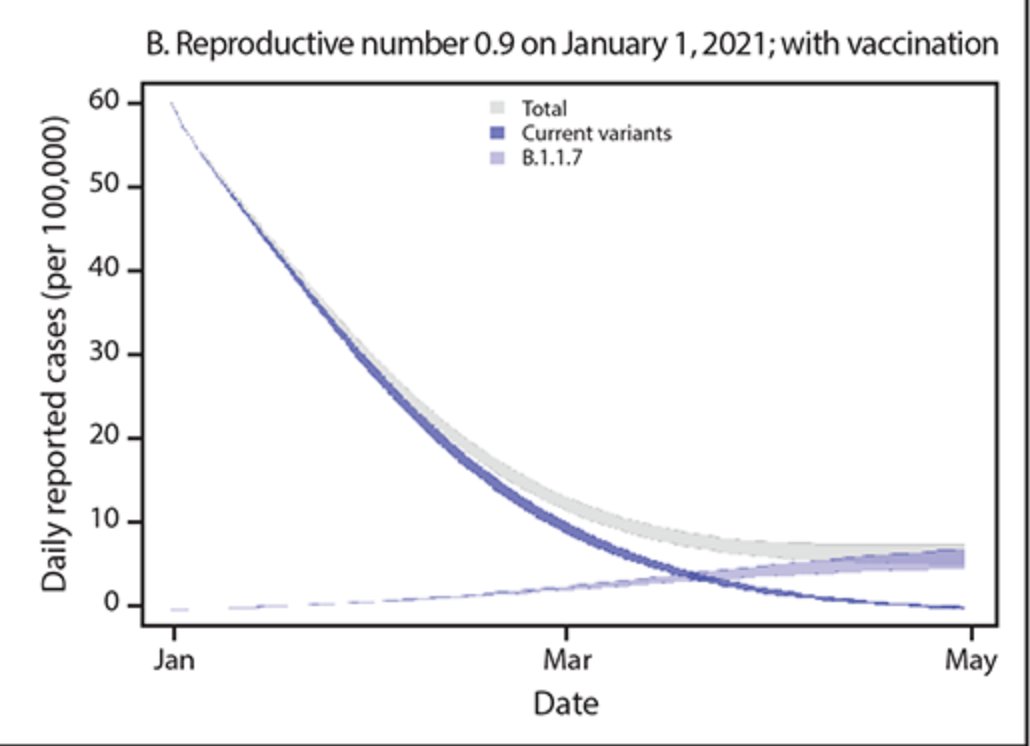
Just because a variant becomes the dominant strain does not automatically mean we will see a repeat of Fall 2020.
Let's look at UK and South Africa, where cases have been falling for the past month, in unison with the US (albeit with tougher restrictions):
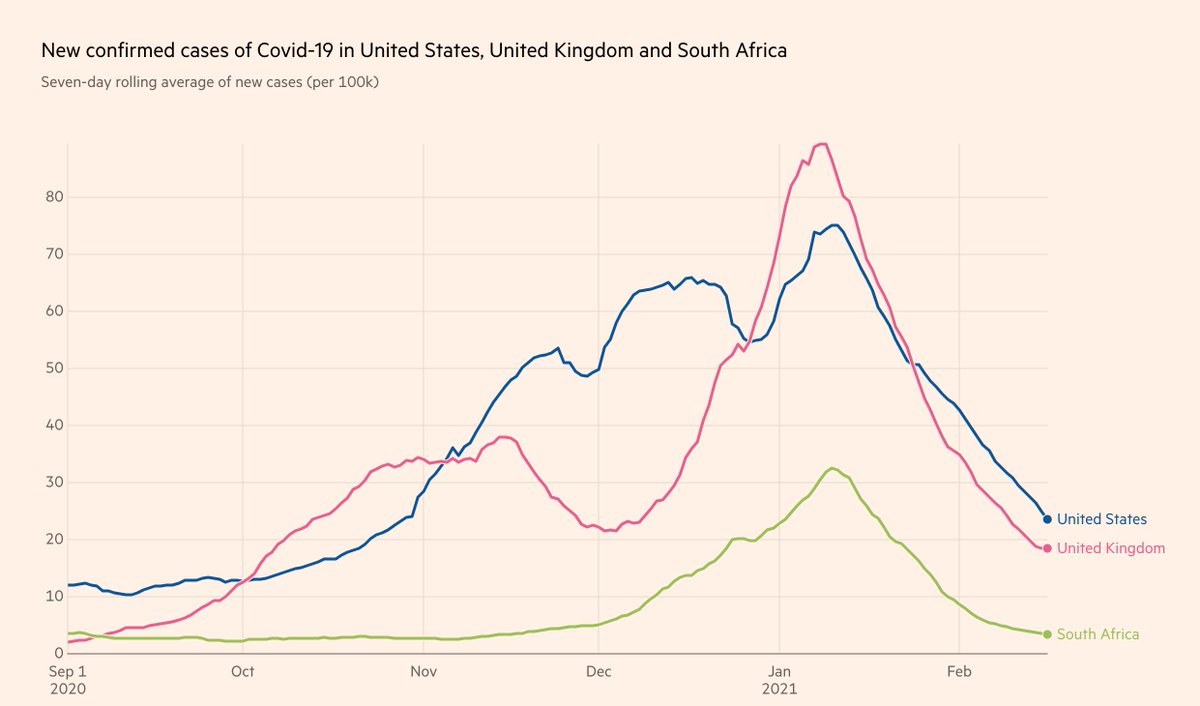
Furthermore, the claim that the "variant is doubling every 10 days" is false. It's the *proportion of the variant* that is doubling every 10 days.
If overall prevalence drops during the studied time period, the true doubling time of the variant is actually much longer 10 days.
Simple example:
Day 0: 10 variant / 100 cases -> 10% variant
Day 10: 15 variant / 75 cases -> 20% variant
Day 20: 20 variant / 50 cases -> 40% variant
1) Proportion of variant doubles every 10 days
2) Doubling time of variant is actually 20 days
3) Total cases still drop by 50%
While this will likely to be the case, this should not be an automatic cause for concern. Cases could still remain contained.
Here's how: 🧵
One of @CDCgov's own models has tracked the true decline in cases quite accurately thus far.
Their projection shows that the B.1.1.7 variant will become the dominant variant in March. But interestingly... there's no fourth wave. Cases simply level out:
https://t.co/tDce0MwO61

Just because a variant becomes the dominant strain does not automatically mean we will see a repeat of Fall 2020.
Let's look at UK and South Africa, where cases have been falling for the past month, in unison with the US (albeit with tougher restrictions):

Furthermore, the claim that the "variant is doubling every 10 days" is false. It's the *proportion of the variant* that is doubling every 10 days.
If overall prevalence drops during the studied time period, the true doubling time of the variant is actually much longer 10 days.
Simple example:
Day 0: 10 variant / 100 cases -> 10% variant
Day 10: 15 variant / 75 cases -> 20% variant
Day 20: 20 variant / 50 cases -> 40% variant
1) Proportion of variant doubles every 10 days
2) Doubling time of variant is actually 20 days
3) Total cases still drop by 50%


























